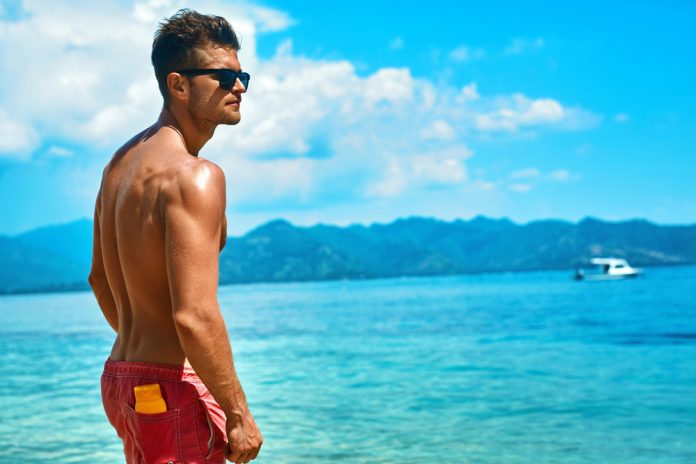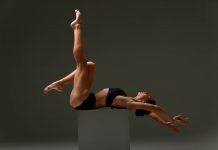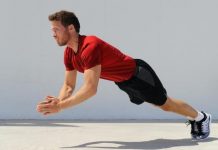The perfect body workout is your guide to the most sought-after male physique attributes, and how any guy can finally achieve them.
Let’s not kid each other: as much as we hit the gym to feel awesome, live longer, compete with our buddies, relieve stress, and, of course, have a damn good time slinging giant pieces of steel, it doesn’t hurt that working out makes us look damn good, too.
Which means that, if you’re a guy seeking to round out your sex appeal, you’re probably more than familiar with all the coveted (admittedly superficial) physical attributes that constitute a “perfect male body physique”—the ones even hardcore gym rats have trouble achieving.
These include the well-defined arm “horseshoe” (see: Mark Wahlberg in The Fighter), ridiculously chiseled V-cut abs (see: Brad Pitt in Fight Club), and the giant wingspan of a well-carved upper back (see: Hugh Jackman in any film in which he sprouts metallic claws).
So, with the help of some of the nation’s best trainers, strength coaches, and strongmen, we’ve laid out in exhaustive detail everything it takes to achieve a prime body physique.
Goal #1: A Tapered Torso
Remember the old adage that “abs are made in the kitchen?” Well, the same principle applies to your entire midsection. “You can do all the gym work in the world,” says Zach Even-Esh, founder of New Jersey’s The Underground Strength Gym, “but if your body’s covered by a layer of fat, then nobody will know.”
That’s why getting yourself on a very strict, clean diet—with the right balance of proteins, fats, and carbs—is the key to transforming your flabby torso into a perfectly cut, tapered midsection.
But how do you do it?
A Good Diet Plan
The first order of business is to get your math in order, and that means calculating what your overall calorie intake needs to be, says sports nutritionist and strength coach C.J. Murphy, MFS, owner of Total Performance Sports, in Malden, MA.
So if pure fat loss is your goal, you need to set the goal of ingesting roughly eight to 12 calories per pound of your entire body weight per training day, depending on how active you are and how much fat you need to shed. (And remember: Be honest with yourself.)
If you’re already fairly lean and you just want better muscular definition, you’re allowed 12 to 15 calories per pound of body weight. (Though it’s best to start on the low end and see how it goes.) So if you’re a 200-pound guy looking to get lean, at 10 calories per pound, you’re looking at roughly a 2,000-calorie-per-day diet.
Now what should it be?
Well, Murphy recommends a simple high-protein carb-cycling program, with which you eat more carbohydrates on your strength training days and less on days off, creating a caloric deficit that torches fat.
So let’s start with strength-training days.
First, of course, you’ll need lots of lean protein. “That includes anything that swims, runs, or flies,” says Murphy. Meaning: steak, chicken, fish, turkey, and ground beef. Eggs and protein powder are good, too. As a rule of thumb, Murphy calculates meats at 7 grams of protein per ounce.
“Different foods have different values, yes, but if you’re eating a wide variety of meats you’ll still be in the ballpark, which is what we want.” All told, that means roughly 1g of protein per pound of body weight (calculated at 4 calories per gram). So that same 200-pound guy needs to eat 200g of protein every gym day.
Then there are carbs: Yams, sweet potatoes, white rice, white potatoes, and fruit are all good carbs to power your workouts. Those carbs should make up 35-45% of your daily calories, calculated at 4 calories per gram. We’ll give our guy 220g.
The remainder of your calories each day can be made up of vegetables and healthy fats, like nuts, nut butters, olive oil, and avocado. (Calculate fats at 9 calories per gram.) For our guy, that comes to roughly 35g of fat.
On non-strength-training days, you should cut carbs up to 50% and increase fat to 20-30% of total calories to help fill you up, reduce hunger pangs, and increase your likelihood of sticking to it. So our example guy should eat 200g of protein, 125 g of carbs, and 50g of fat for a total of 1,750 calories. But when you eat is important, too.
“Earn your carbs,” says Murphy, which means you should be ingesting carbs directly pre- and post-workout. Also, save the bulk of your off-day carbs for the evening, which prevents you from bingeing at night and gives you a little more energy (in the form of stored glycogen) to carry into the next morning.
“Carb cycling isn’t the only way to put on lean muscle mass, but it’s the simplest,” Murphy says. “It’s easy, people get it, and it’s hard to screw up.”
Goal #2: A Broad Chest
“Nobody likes a chicken chest,” says trainer Murphy, and we can’t argue with him. If you want to project an image of strength and power, a broad, chiseled chest is one of the oldest, most time-honored ways of doing it. But there are better ways to build pecs than the bench press.
“The bench does work the chest,” Murphy says, “but it also works a bunch of related muscles, like the deltoids and triceps, among others.” With these other exercises added to your once-a-week pec workout, you’ll have a “chest you can balance a beer on” in no time.
Murphy first suggests the highly underrated decline dumbbell press. “It activates more available pec fibers than any other exercise,” he says. “It’s almost all pec because the range of motion is so short that your delts and triceps don’t do a ton of work.”
The angle also allows you to use heavier weights, which equates to more work and a bigger chest. (Using a weight that allows 10 to 12 reps on your first set, perform five sets, pushing each one until you’re one rep shy of failure.)
Then it’s on to flyes. Murphy advises using bands or chains to put less wear and tear on the shoulders. (When the weight unloads as you go down on chain flyes, your shoulders will be safer at the bottom and you’ll get a more powerful pec contraction at the shoulder.)
With bands, you can loop an exercise band around each hand and behind your back before picking up dumbbells. (Do four sets of 15 to 20 reps.)
Finally, “dips are like the squat for the upper body,” says Murphy, “in that they’re a great way to increase pec mass.” They press the muscles fully and also hit stabilizing lats and abs hard when done with proper technique. (Perform 50 dips in as few sets as possible.)
But to really stimulate growth, try suspension trainer flyes, which utilize full-body tension. “Plus, it’s done from an angle that you hardly ever use when doing presses, which creates a totally new stimulus that causes your nervous system and muscles to work differently, stimulating growth,” Murphy says.
To do it, ensure that you’re maintaining a strong plank position throughout each flye. Perform 40 total in as few sets as possible, using a body angle of 45 degrees.
Goal #3: A Triceps Horseshoe
News flash: though biceps are cool, triceps actually make up the bulk of the upper arms. Growing big arms and—even more impressive, carving out a detailed triceps horseshoe—means working every part of the muscle.
“You need to make sure you hit all three heads of the muscle—long, medial, and lateral,” says Noah Bryant, C.S.C.S. “While you can’t completely isolate them, you can do exercises that emphasize each one.”
Best Tricep Workouts
Add these three moves to your routine as much as twice per week—on chest day and shoulder day.
1. EZ-curl bar French Press
The first exercise, which hits your triceps’ “long head,” is the EZ-curl bar French press.
How to do it:
Sit on a bench and grasp the EZ-curl bar with a pronated grip.
Start with straight arms and the bar directly overhead.
Lower the bar by bending your elbows.
Go as far as you can while keeping your back, neck, and upper arms straight and perpendicular to the ground.
It’s important to perform the full range of motion if you want better results.
Return the weight under control to the overhead starting position.
2. Triceps Dip
Then the triceps dip is Bryant’s top choice for hitting this deep-down part of the triceps.
How to do it:
Set up on a dip bar like you would for normal dips, only this time you’ll keep your body straight up and down (perpendicular to the ground) and your feet underneath you rather than crossed behind you.
Lower yourself until your forearm and upper arm make a 90-degree angle, then push yourself back up.
3. Lateral Head
To hit the lateral head, Bryant suggests straight-bar cable pushdowns. “The lateral head is the one most responsible for the ‘horseshoe’ shape of the triceps,” Bryant says, “and working it is extremely important to get that look.”
Any movement that pushes weight down will hit the lateral head, which runs on the outside of the arm, but this is his favorite.
How to do it:
Start with the bar about chest level, your elbows in tight to your body, and your upper arms pointing straight down to the ground.
Keep your elbows tucked tightly in to your body, and push the bar down while keeping your upper arms static.
Feel your triceps moving the weight—and your horseshoe getting more and more cut.
Goal #4: Strong, Well-developed Glutes
To really fill out a pair of blue jeans with an amazing rear, Toronto-based coach and personal trainer Lee Boyce, C.P.T., put together this stand-alone workout you should add to your routine as many as two days a week.
Stick with the order described here—from most isolated to most dynamic—so you start with the heavier lifts. That way your body will recruit more fast-twitch fibers, which is key to building strength.
But a few ground rules to ensure you’re doing them right:
Always maintain a neutral spine, and don’t round or arch your back.
Press through your heels.
Make sure your hips are always the pivot point.
Start light, and make small progressions.
Best Glute Exercises
1. Barbell Hip Thrust
First: the barbell hip thrust, a building-block exercise that helps train the hip-hinge movement without having to coordinate other joints for an effective workout.
How to do it:
Sit on the floor and roll a loaded barbell into your lap.
Lie back with your shoulders against a bench, bend your knees, and plant your feet on the floor.
Then drive through your heels so you raise your hips off the floor to full extension.
2. Sumo Deadlift
Sumo deadlift, a deadlift variation that uses a wider stance—with toes rotated further out—to better activate the glutes.
How to do it:
Be sure to use a narrow grip (inside your legs), push your hips back, and lean slightly forward to grab the barbell.
Keep the barbell close to your body as you lower it back down.
3. Dumbbell Set Up
Finish with the dumbbell step up, which works the posterior chain even harder.
How to do it:
Start by standing behind a bench that brings your thigh parallel to the floor when your foot is on top.
Hold a dumbbell in each hand and step up onto the bench, but leave your trailing leg hanging off.
Return to the starting position.
Goal #5: A Wide Upper Back
A strong, wide upper back doesn’t just look great, says Jeb Stuart Johnston, C.P.T., a Brooklyn-based Strongman. It opens up your shoulders and improves posture. You stand taller and appear more confident.
To get there, Johnston recommends hitting the upper back with some of the same full-body functional movements that are central to Strongman competitions. Loaded carries force every muscle in the body to work together to lift and stabilize heavy odd objects, and much of the load is placed on the upper back.
They also provide tremendous cardiovascular benefit. “Any of these would be great as a finisher on back day,” he says, “or try pairing them with sled pulls and car pushes to make your own ‘Strongman Saturday.’”































